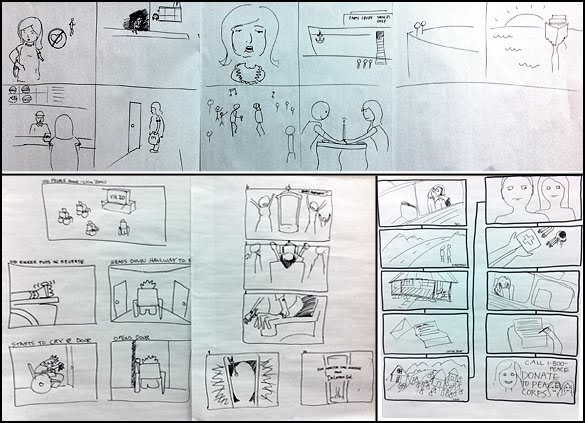
Visual Thinking School
Adding Music to the Visual—Exploring the Powerful Role Music Plays in Visual Storytelling
Date: Thursday, July 15, 2010
Run by: Tyson Mangelsdorf
Notes by: Tyson Mangelsdorf
Attendees: Matt Adams, Deanna Rizzo, Stephanie Swain, Ryan Smythe, Teija Springman, Eve Curry, Charyl Looper, Marvin Gaviola, Tyson Mangelsdorf
Libations: Drop Top Amber, Full Sail Amber, Miller Genuine Draft (in the tall can)
Ingredients: Keynote, YouTube, iTunes, audio speakers, whiteboard, chart paper, markers
Agenda:
4:00 pm - Welcome
We all settled in the Ant room. As drinks and snacks casually trailed from the center of the large meeting table into the warm, dark digestive tracts of each attendee, light chatter and ambient background music filled the room. I purposely cut the music, and the chatter halted. All was quiet. Everyone's attention was on the music-killer.
I smiled and appealed, "Music has a powerful grasp on us, doesn't it?" Everyone agreed. It had added quite a blanket of ambience to the room, but we had all taken it for granted until it was stripped away.
From here, I welcomed everybody, introduced our subject, and went into the ice breaker.
4:10 pm - Ice Breaker
Everyone had to write down their name and a song that carried emotional resonance for them—a song, that everytime they heard it
 4:20 pm - An Exploration of the
4:20 pm - An Exploration of the
Emotional Power of Music
We started by watching a video about the ways sound affects us.
From the video, we came away with 4 golden rules about adding sound to any narrative.
 4:30 pm - Excercise One
4:30 pm - Excercise One
Music sticks with us, particularly when it's linked to a narrative. To prove the point, we went right into a quick, fun excercise where I played three movie score tracks and everyone could pitch guesses to which movie they were from. They were all guessed within a few tries, except the last one took more to identify exactly which space-movie it went with.
The tracks were:
- Back to the Future
- Misirlou (Pulp Fiction)
- I am a Man of Constant Sorrow (O Brother Where Art Thou)
- Star Trek II-The Wrath of Khan
4:30 pm - Sampling Animation with Music
Changing the soundtrack behind an animation really affects our perception of the visual story. We viewed an animation and changed the music track behind it as we rewatched the same scene. The music style ranged from classical, to jazz, to electronic, to modern alternative. Everyone in the room described the significantly different interpretation of the scene due to the change in music. It was amazing. After the first animation, we viewed another sample and performed the same review.
The animations we reviewed are here:
5:00 pm - Exercise Two
Listen to a song that continuously loops for 20 minutes and draw on big paper what it emotionally conveys and what imagery comes to mind. We listened to Moby's song Rushing.

5:20 pm - Exercise Three
Everyone got in groups of three or four and had to choose one of their beloved songs from the ice breaker to storyboard an animation promoting a product or service. It could be fictitious or real, but they had to use the song as the backing track. The song must propel their concept into greater meaning.
The songs chosen were:
- I Wanna Dance With Somebody (Whitney Houston)
- Here I Go Again (Whitesnake)
- Rowing Song (Patty Griffin)

5:55 pm - Plus/Delta
Overwhelming, everybody enjoyed the VTS and had insightful, constructive feedback.

No comments:
Post a Comment